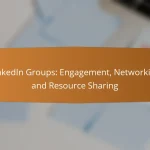A compelling LinkedIn headline is essential for effectively conveying your professional identity and the value you bring to potential connections or employers. By incorporating relevant keywords and tailoring your message to your target audience, you can create a concise and engaging headline that captures attention and opens doors to new opportunities.
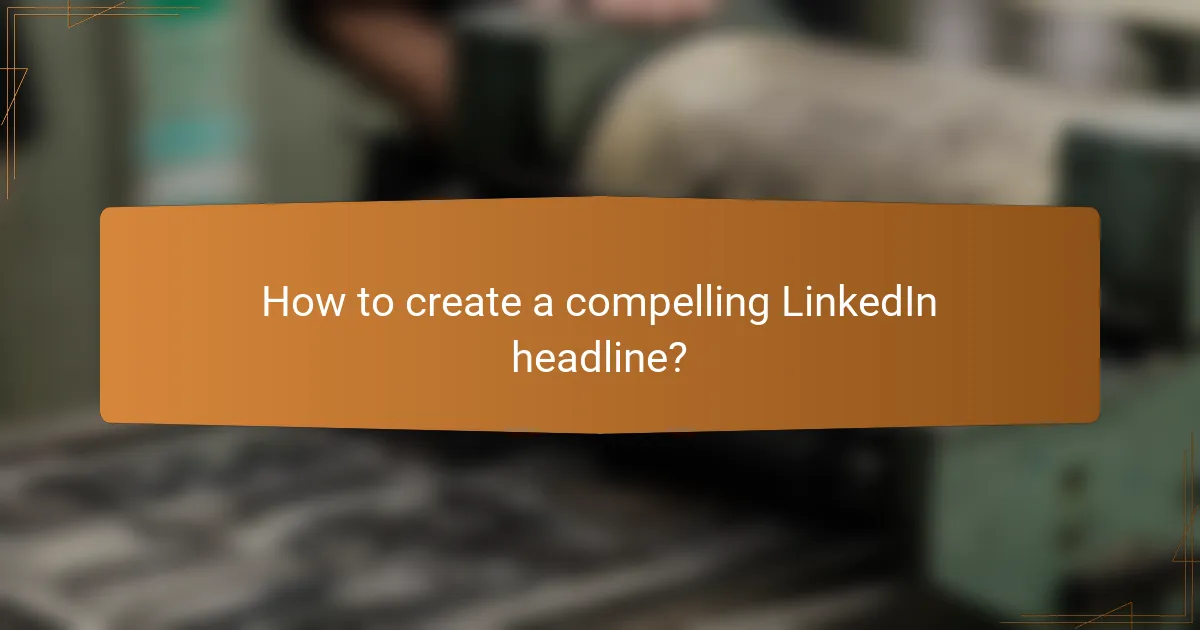
How to create a compelling LinkedIn headline?
A compelling LinkedIn headline clearly communicates your professional identity and value to potential connections or employers. It should be concise, engaging, and tailored to your target audience, making it easy for them to understand what you offer.
Focus on your unique value proposition
Your unique value proposition (UVP) highlights what sets you apart from others in your field. Consider your skills, experiences, and achievements that directly benefit your target audience. For example, instead of saying “Marketing Specialist,” you might say “Digital Marketing Specialist Driving 30% Growth for E-commerce Brands.”
To identify your UVP, reflect on your past successes and the specific problems you solve. This clarity will help you craft a headline that resonates with your audience and showcases your strengths.
Use industry-specific keywords
Incorporating industry-specific keywords into your LinkedIn headline enhances your visibility in searches. Use terms that potential employers or clients are likely to search for, such as “Data Analyst,” “Software Engineer,” or “Project Manager.” This will help you appear in relevant searches and attract the right opportunities.
Research common keywords in your industry by reviewing job postings or profiles of successful professionals. Aim to include 2-3 key terms in your headline to optimize your profile without overloading it with jargon.
Incorporate a call to action
A call to action (CTA) in your LinkedIn headline encourages engagement and invites connections. Phrases like “Let’s connect,” “Open to opportunities,” or “Contact me for collaboration” can prompt viewers to take the next step. This makes your profile more approachable and can lead to valuable networking opportunities.
When crafting your CTA, keep it brief and relevant to your goals. For instance, if you are looking for freelance work, you might say “Freelance Graphic Designer – Let’s collaborate!” This not only informs visitors of your availability but also encourages them to reach out.

What makes a targeted LinkedIn headline?
A targeted LinkedIn headline clearly communicates your professional identity and value to a specific audience. It combines relevant keywords, skills, and experiences to attract the right connections and opportunities.
Identify your target audience
Understanding your target audience is crucial for crafting a compelling LinkedIn headline. Consider who you want to connect with, whether they are recruiters, potential clients, or industry peers. Tailoring your headline to resonate with this group will enhance your visibility and engagement.
To identify your audience, ask yourself questions like: What industries do they belong to? What roles do they hold? What challenges do they face? This insight will help you choose the right language and focus for your headline.
Highlight relevant skills and experiences
Your LinkedIn headline should prominently feature skills and experiences that are pertinent to your target audience. Use industry-specific terminology and keywords that potential employers or clients are likely to search for. This not only improves your searchability but also positions you as an expert in your field.
For example, if you are a digital marketing specialist, include terms like “SEO,” “content strategy,” or “social media management.” Aim to balance specificity with broad appeal, ensuring your headline reflects both your unique strengths and the needs of your audience.
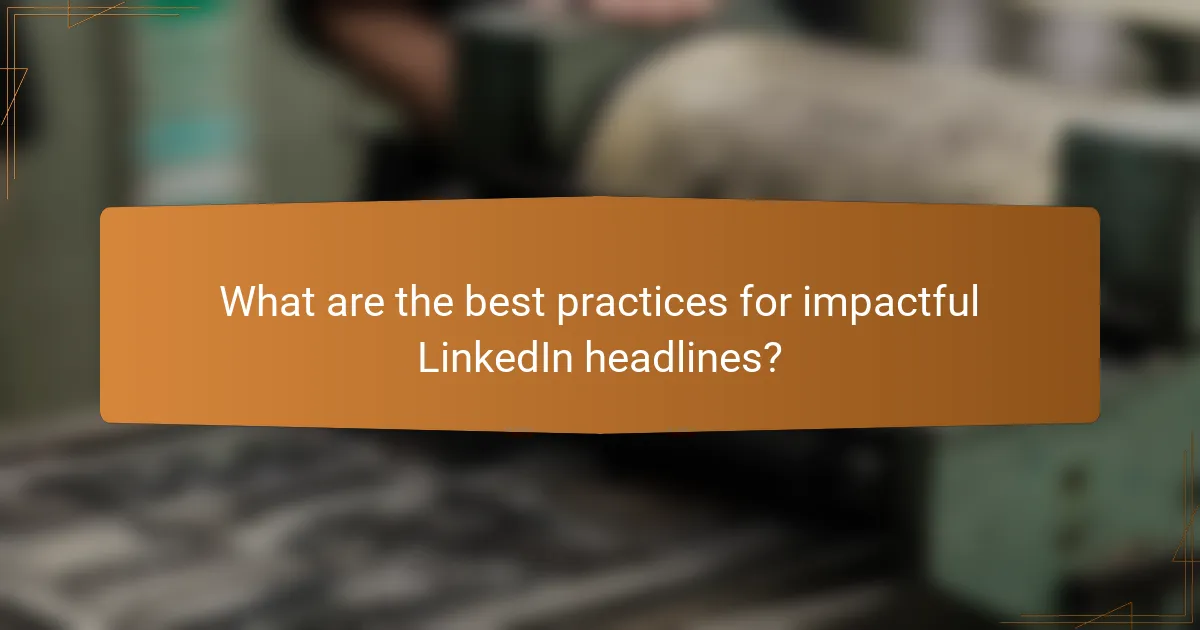
What are the best practices for impactful LinkedIn headlines?
To create impactful LinkedIn headlines, focus on clarity, relevance, and engagement. A well-crafted headline should convey your professional identity and attract the right audience.
Keep it concise and clear
Your LinkedIn headline should be straightforward and to the point. Aim for around 120 characters to ensure it displays well across devices and captures attention quickly.
Use simple language and avoid jargon unless it’s widely understood in your industry. A clear headline helps potential connections grasp your expertise at a glance.
Use numbers and metrics
Incorporating numbers or metrics can significantly enhance your headline’s impact. For example, stating “Increased sales by 30% in 6 months” provides concrete evidence of your abilities.
Consider including quantifiable achievements or relevant statistics that highlight your skills. This approach not only boosts credibility but also makes your profile more memorable.
Personalize for your niche
Your headline should reflect your unique value proposition tailored to your specific industry or profession. Use keywords relevant to your niche to improve visibility in searches.
For instance, if you are in digital marketing, include terms like “SEO Specialist” or “Content Strategist” to attract the right audience. Personalization helps you stand out in a crowded marketplace.

How to optimize LinkedIn headlines for lead generation?
To optimize LinkedIn headlines for lead generation, focus on incorporating relevant keywords and showcasing your expertise. A compelling headline can attract potential clients and enhance your visibility in search results.
Include keywords for search visibility
Using targeted keywords in your LinkedIn headline is crucial for improving search visibility. Identify terms that your target audience is likely to use when searching for services or expertise similar to yours.
Consider including industry-specific jargon or phrases that resonate with your ideal clients. For example, if you are a digital marketing consultant, terms like “SEO Specialist” or “Content Marketing Expert” can help you stand out.
Showcase your expertise
Your LinkedIn headline should clearly reflect your professional expertise to attract the right leads. Highlight your unique skills or qualifications that differentiate you from competitors.
For instance, instead of a generic title, you might say “Certified Financial Planner Helping Small Businesses Grow” to convey both your certification and your target audience. This clarity can lead to higher engagement rates.
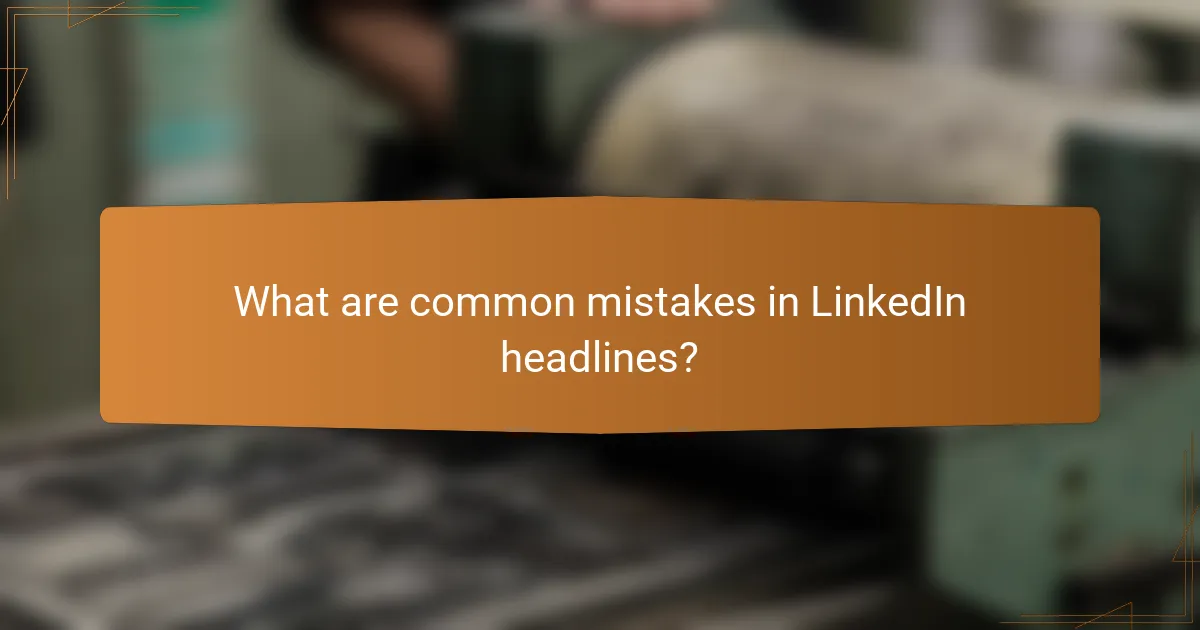
What are common mistakes in LinkedIn headlines?
Common mistakes in LinkedIn headlines include using jargon or buzzwords and being too vague or generic. These pitfalls can prevent your profile from standing out and effectively communicating your professional identity.
Using jargon or buzzwords
Overusing jargon or buzzwords can make your LinkedIn headline sound insincere or overly complicated. Terms like “synergy,” “thought leader,” or “disruptor” may impress some, but they often fail to convey your true skills and expertise.
Instead, focus on clear and straightforward language that accurately reflects your role and achievements. For example, instead of saying “dynamic marketing strategist,” consider “marketing professional with a track record in digital campaigns.” This approach is more relatable and impactful.
Being too vague or generic
A vague or generic headline does not effectively communicate your unique value. Phrases like “experienced professional” or “hardworking individual” do not provide specific information about your skills or industry.
To improve clarity, include specific details about your role, industry, or key skills. For instance, instead of “sales manager,” use “sales manager specializing in B2B technology solutions.” This specificity helps potential connections understand your expertise and how you can add value.
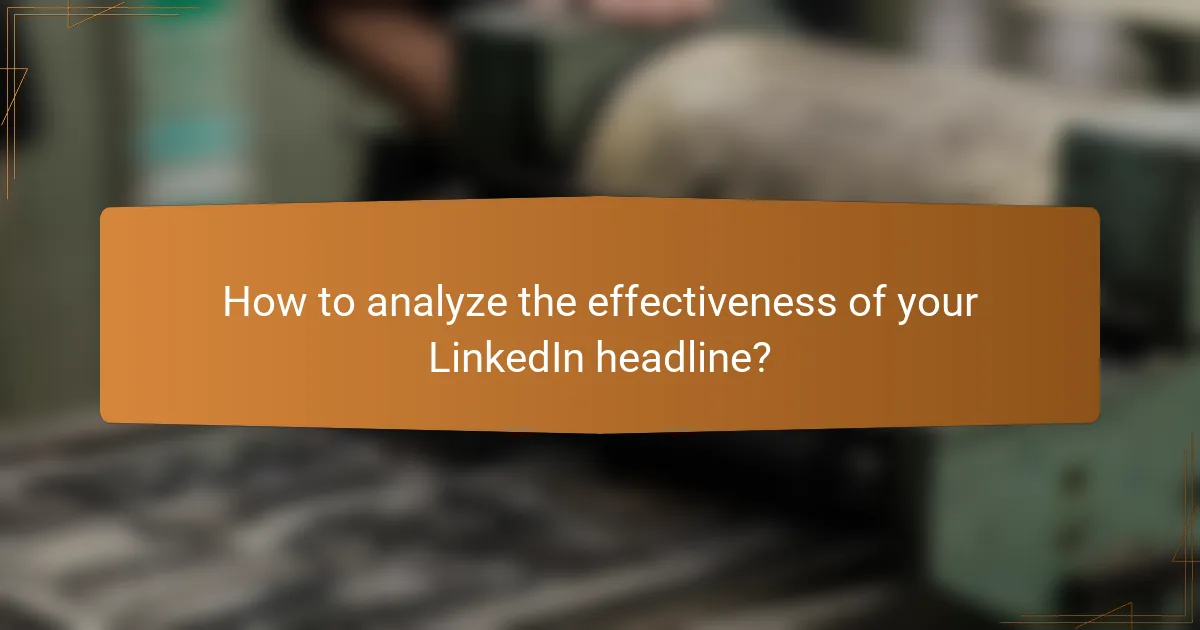
How to analyze the effectiveness of your LinkedIn headline?
To analyze the effectiveness of your LinkedIn headline, focus on measurable outcomes such as profile views and connection requests. These metrics provide insight into how well your headline attracts attention and engages potential connections.
Track profile views and connection requests
Monitoring profile views and connection requests is essential for assessing your LinkedIn headline’s impact. A significant increase in profile views after updating your headline suggests it resonates well with your target audience.
Consider using LinkedIn’s analytics tools to track these metrics over time. Aim for a consistent rise in views and requests, ideally in the range of 10-30% after making changes to your headline.
Solicit feedback from peers
Gathering feedback from peers can provide valuable insights into your LinkedIn headline’s effectiveness. Ask colleagues or industry contacts to review your headline and share their impressions on its clarity and appeal.
Utilize a simple survey or informal conversation to collect their thoughts. Look for common themes in their feedback, and consider making adjustments based on their suggestions to enhance your headline’s impact.
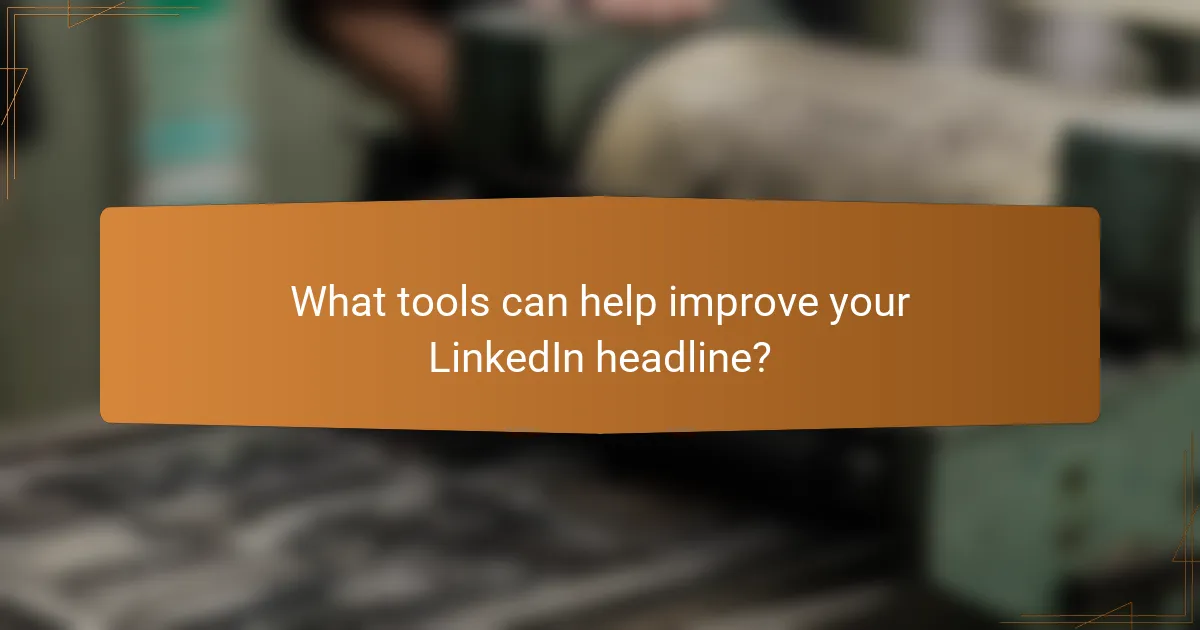
What tools can help improve your LinkedIn headline?
Several tools can enhance your LinkedIn headline by providing insights and optimization suggestions. These tools analyze your current headline and offer recommendations to make it more compelling and targeted for your audience.
LinkedIn Headline Analyzer by CoSchedule
The LinkedIn Headline Analyzer by CoSchedule evaluates your headline based on various factors, including word choice and emotional impact. It provides a score that reflects how effective your headline may be in attracting attention.
To use this tool, simply enter your headline and review the feedback. Aim for a score in the high 70s or above for optimal impact. Consider incorporating action verbs and industry-specific keywords to enhance your score.
Headline Optimizer by Sharethrough
Sharethrough’s Headline Optimizer focuses on crafting headlines that drive engagement. It analyzes your headline’s structure and suggests adjustments to improve clarity and appeal.
When using this tool, pay attention to its recommendations regarding length and phrasing. A good headline typically ranges from 40 to 70 characters, making it concise yet informative. Avoid jargon and ensure your headline resonates with your target audience for better results.
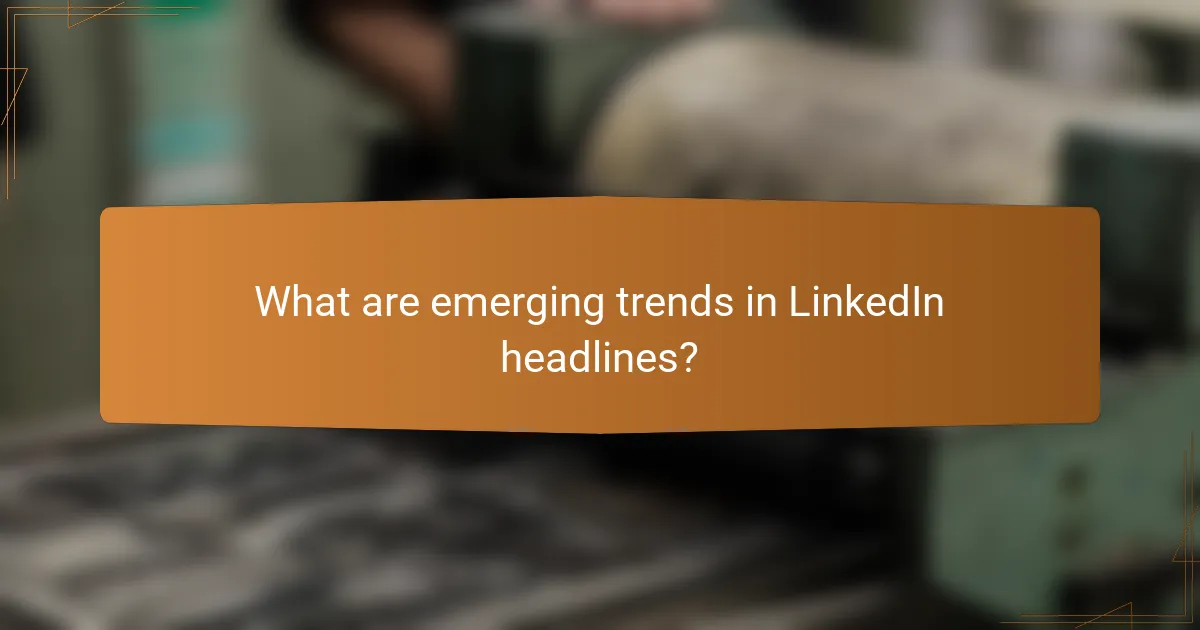
What are emerging trends in LinkedIn headlines?
Emerging trends in LinkedIn headlines focus on clarity, specificity, and personal branding. Professionals are increasingly using headlines to showcase their unique value propositions and skills, making them more compelling and targeted.
Personal Branding
Personal branding in LinkedIn headlines emphasizes individuality and expertise. Professionals are encouraged to highlight their unique skills, experiences, and values, which helps them stand out in a crowded job market. For example, instead of a generic title like “Marketing Manager,” one might use “Digital Marketing Strategist | Driving Growth through Data-Driven Campaigns.”
To create an effective personal brand, consider what sets you apart from others in your field. Use keywords relevant to your industry and roles you aspire to, ensuring they resonate with your target audience.
Keyword Optimization
Keyword optimization involves using relevant terms that recruiters and potential connections are likely to search for. Incorporating industry-specific keywords into your LinkedIn headline can significantly enhance visibility and attract the right opportunities. Aim for a balance between being descriptive and engaging.
For instance, a software engineer might include terms like “Full-Stack Developer” and “JavaScript Expert” to improve searchability. Regularly update your keywords to reflect changes in industry trends and your evolving career goals.
Conciseness and Clarity
Conciseness and clarity are crucial for creating impactful LinkedIn headlines. A well-crafted headline should be brief yet informative, ideally within 120 characters. This ensures that your message is clear and easily digestible at a glance.
Avoid jargon and overly complex language. Instead, focus on straightforward phrases that convey your professional identity and aspirations. For example, “Sales Leader | Building Relationships & Driving Revenue” is clear and to the point.
Emotional Appeal
Incorporating emotional appeal into your LinkedIn headline can create a stronger connection with your audience. This can be achieved by expressing passion for your work or highlighting the impact you aim to make in your industry.
For example, a nonprofit professional might use “Advocate for Social Change | Empowering Communities through Education.” This not only conveys their role but also their commitment to a cause, making it more relatable and engaging.


